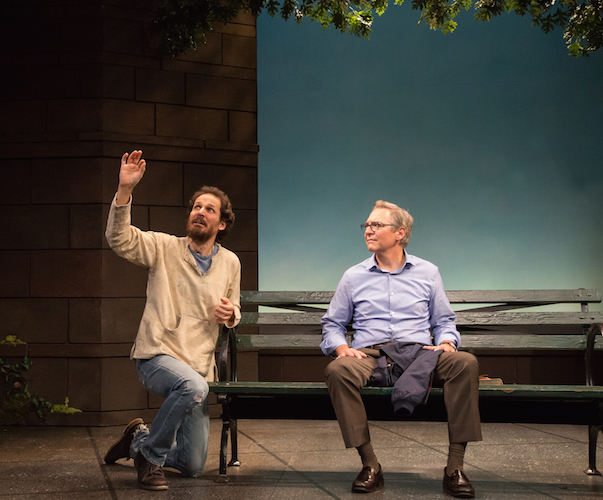Theater Review: “At Home at the Zoo” — Edward Albee’s Perfect Pairing
To see a production of this high quality in a small theater was a privilege.
Edward Albee’s At Home at the Zoo. Directed by Eric Hill. Presented by Berkshire Theatre Group. At Unicorn Theatre, Stockbridge, MA, through August 26.

David Atkins and Tara Frankin in Berkshire Theatre Group’s production of “Edward Albee’s At Home at the Zoo.” Photo: Emma Rothenberg-Ware.
By Helen Epstein
Edward Albee’s first-produced play, the one-act The Zoo Story, opened in January of 1960 at New York’s Provincetown Playhouse alongside Samuel Beckett’s Krapp’s Last Tape to mixed reviews. But off-Broadway audiences loved George Maharis (of TV’s Route 66), who played what was then called a “bum,” now a “street person,” and made Albee a rising star two years before Who’s Afraid of Virginia Woolf?
Zoo Story was a quintessentially New York play, referencing one of Manhattan’s most-frequented leisure sites. Shabbily dressed, aggressive and transient (rather than homeless), Jerry is a denizen of an Upper West Side that, in 2017, no longer exists. He is white, lives in one of the many rooming houses and Single Room Occupancy hotels that predated the homeless crisis, and spends his time walking around Manhattan and visiting the zoo.
Well-dressed, mild-mannered Peter, on the other hand, is an upper-middle-class publisher living on East 74th St. On Sundays, he likes to take a break from his wife, two daughters, and two parakeets and find a quiet place to read in Central Park. A park bench is the setting for this astonishingly fresh, startling, and eminently theatrical two-hander, essentially a monologue by the charismatic Jerry to a near-captive Peter.
Albee apparently had long wished to enlarge upon Peter’s back story and, in the early 2000s, nearly 50 years after he wrote the first play, wrote a complementary one-act about Peter and his wife Ann at home.
Berkshire Theatre Group’s marvelous production of At Home at the Zoo, with its gorgeous, classic sets and wonderful cast (David Adkins as a gentlemanly Peter, Tara Franklin as a discontented Ann, and Joey Collins as a manic Jerry) shows that Albee created a perfect pairing. The juxtaposition of the two plays does far more than simply flesh out the character of Peter: it gives Albee an opportunity to examine the nature of communication in our most and least intimate relationships, as well as a play that makes skillful use of one of his favorite techniques: repeating words, phrases, gestures, and actions in new contexts.

Joey Collins and David Adkins in BTG’s production of “Edward Albee’s “At Home at the Zoo.” Photo: Emma Rothenberg-Ware.
“We should talk,” is Ann’s opening line to Peter; “Do you mind if we talk?” is Jerry’s an hour later. Director Eric Hill has studied Albee’s hyper-intelligent script, bringing out all of the nuances in its poetic language. He has also choreographed the action with consummate skill. We can practically see the invisible web of connections between the two pairs of interlocutors.
The two pairs of actors manage to keep one another (and the audience) riveted throughout the two plays. We cannot take our eyes off them or permit ourselves to miss a word of what they say. Their dialogues are written so precisely and musically that I often felt as though I were on a sailboat rhythmically rocking on waves of language.
Having just seen the Barrington Stage Company’s production Stephen Sondheim’s Company, I was struck by how much Sondheim and the late Albee shared in terms of age, education, family dysfunction, sexual orientation, class, and subject matter, the province of white privilege. Both provide a jaundiced view of marriage and a distinct interest in showcasing bitchy, frustrated, emasculating women married to polite, compliant, and recessive men. But Edward Albee’s At Home at the Zoo has a potency that belies its age and a sympathy for its characters that transcends any particular time and place. To see a production of this high quality in a small theater was a privilege.
Helen Epstein reviews regularly for The Arts Fuse. Her new book, The Long Half-Lives of Love and Trauma, will be published in 2018.
Tagged: At Home At The Zoo, Berkshire Theatre Group, Culture Vulture, David Atkins, Edward Albee, Eric Hill, Joey Collins

I looked back at your review. I saw the first production in Hartford when Homelife was called Peter and Jerry. It featured the wonderful Frank Wood (who is currently in Tartuffe at the Huntington).
I recall that Zoo Story felt more metaphysical than the other play, and a bit mismatched. I guess I’ll find out when I see the latest production at the Signature Theater in New York in February for which I just bought tickets.
I’ll take a shot at reviewing that production and we can compare notes. Thanks for your input on this summer production.